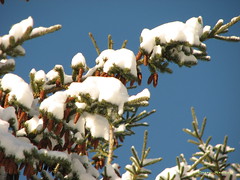 Snow Cat (Photo credit: clickclique)
Snow Cat (Photo credit: clickclique)
We are fortunate here in Aspen, Colorado to have intimate access to so many presentations from well-known and up-and-coming experts on a myriad of topics -- so much so that many of us take these opportunities for granted.
So, after thinking about it for years, I finally availed myself of an interesting lecture series hosted by the Aspen Center for Environmental Studies (ACES). With its Naturalist Nights Series, ACES, together with the Wilderness Workshop and the Roaring Fork Audubon Society, provides an opportunity for nature enthusiasts to listen to, and interact with, visiting and resident presenters discussing the weather and climate, forests, wildlife, and other, related topics.
I went to my first presentation last Thursday, “Forecasting Powder and Other Weather Fun” with Joel Gratz, meteorologist and founder of opensnow.com. OpenSnow is an organization dedicated to providing forecasts, reports “direct from the hill”, and custom snow alerts. Most importantly to us, they try to answer questions like, “When to call in sick for a powder day?”
Entertaining the audience with humor and interesting facts and explanations, Joel conveyed the basics of forecasting snowfall in the various ski areas around the state of Colorado (and specifically Aspen, of course). He addressed, for instance, “Why didn’t we get much snow out of that last storm” and “When ARE we going to get more snow?”
Among the pertinent interesting items we covered were:
- People in every state think they have the corner on the “If you don’t like the weather, wait five minutes” market; but, in fact,
- Colorado/mountain weather IS hard to forecast.
- How the La Niña and El Niño general climate patterns (or lack thereof) affect storm patterns coming to the state.
- How these patterns influence how much moisture a storm brings. According to Joel, storms from the west and the southwest generally “bring the most (heaviest) snow” to our state.
- “Weather happens when moist air gets high” – yes, this did produce some chuckles from the audience.
- Focusing on the effects of orographics (when air mass is forced from a low elevation to a higher elevation as it moves over rising terrain).
- The local wind direction of an approaching storm greatly affects whether or not we will get snow and how much we will get.
- Why radar is not an effective forecasting tool in the mountains.
- The problems with webcams as tracking tools.
- And more at “How To Forecast Your Next Powder Day”.
I’m going to continue attending the Naturalist Night Series presentations at ACES in Aspen. I’m confident I will find all of them to be as interesting and entertaining as this one was; and useful -- I think many of us are now more confident that we’ll know when it’s worth it to plan the old, “I’m not feeling well”, phone call to the boss!
This Thursday’s presentation in Aspen: “The Future Forest: Understanding our Forests and Efforts to Protect Them” with Dr. Tony Cheng, PhD.

No comments:
Post a Comment